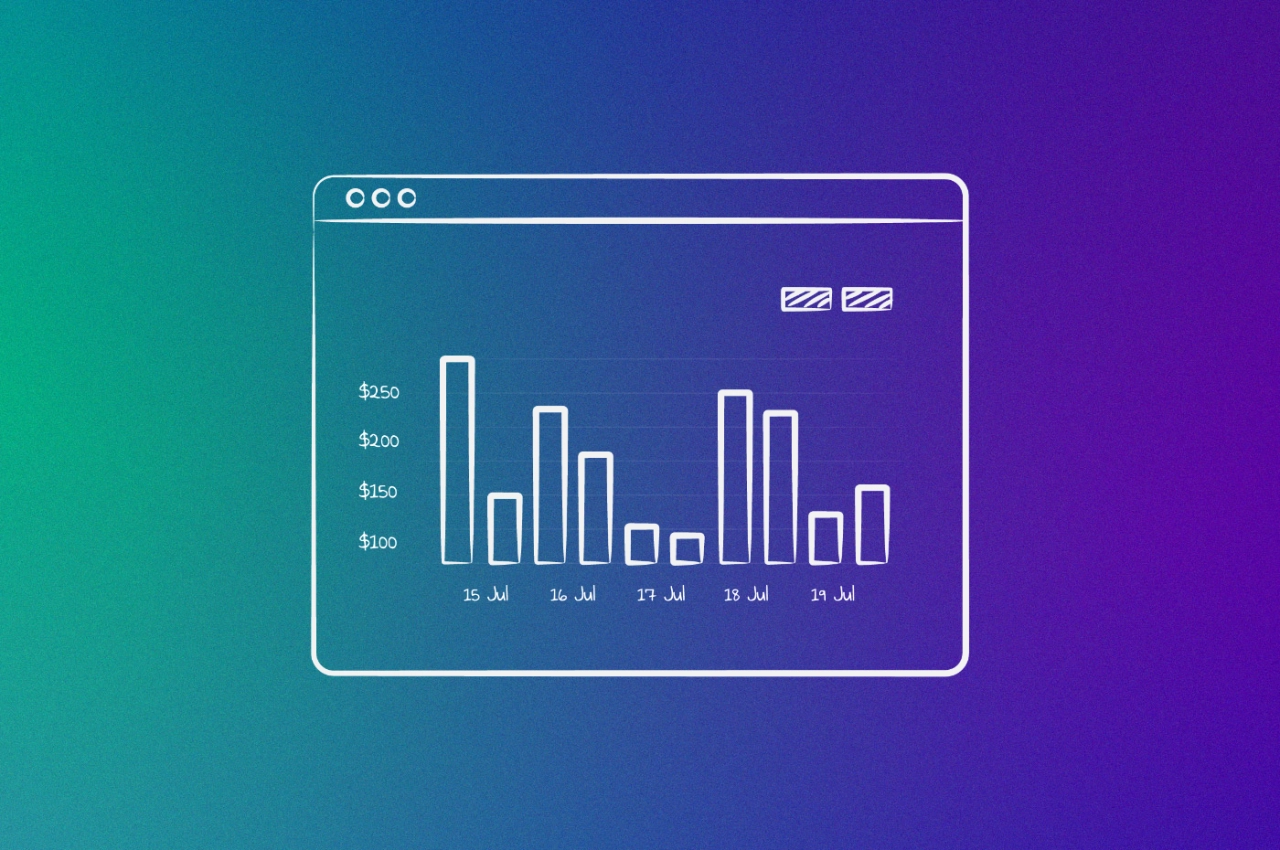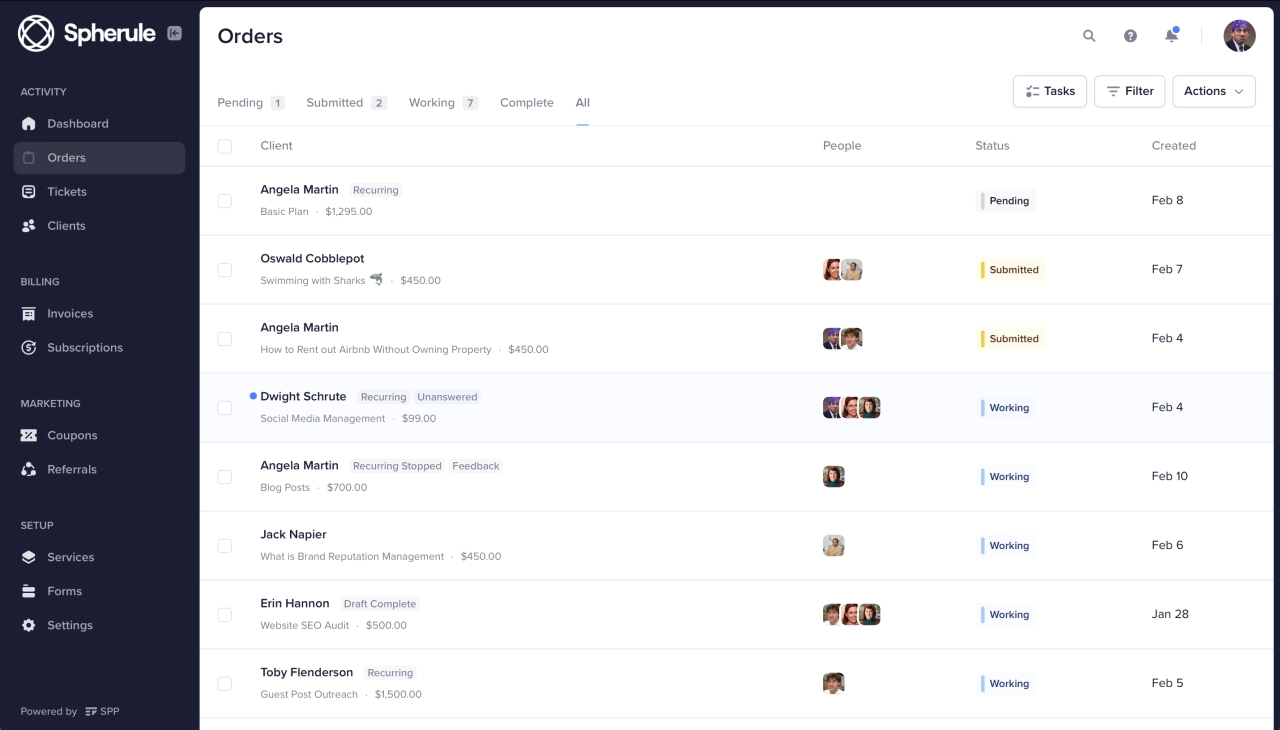- Business development is the strategic work that makes deals possible—positioning, partnerships, and lead generation—while sales is just the final step of closing.
- New agencies should spend 70% of BD effort on outbound and 30% on inbound, then flip that ratio as reputation and referral networks mature.
- Existing clients are 3-4x more likely to buy than new prospects, making account expansion the fastest path to revenue growth.
Every agency owner knows the feeling. One month you’re turning down work, the next you’re wondering where your pipeline went. Feast or famine. It’s the default state for most marketing agencies, and it doesn’t have to be.
The agencies that break out of this cycle aren’t necessarily better at their craft. They’re better at business development (BD). They’ve figured out how to generate leads, close deals, and grow accounts without the constant scramble.
I learned this the hard way running my own agency. We were good at the work but terrible at keeping the pipeline full. When I built SPP.co, I wanted to solve the operational chaos, but I quickly realized that operations only matter if you have clients to serve.
This guide covers what actually works for agency business development: how to attract clients, convert them, and turn them into repeat buyers. No theory. No fluff. Just the strategies I’ve seen work for hundreds of agencies using SPP.co, plus insights from agency owners who’ve figured this out.
Understanding this topic involves several interconnected concepts:
- Lead Generation
- Niching
- Productized Service
- Client Onboarding
- Client Lifetime Value (CLV)
- Churn Rate
- Retainer Model
- CRM (Customer Relationship Management)
Each of these concepts plays a crucial role in the overall topic.
What is business development for agencies?
Business development is everything you do to grow revenue. Finding new clients. Expanding existing accounts. Entering new markets. It’s the engine that keeps your agency moving forward.
People confuse BD with sales, but they’re not the same thing. Sales is closing deals. BD is the strategic work that makes those deals possible in the first place: positioning, partnerships, lead generation, market research. Sales is the last mile. BD is the road that gets you there.
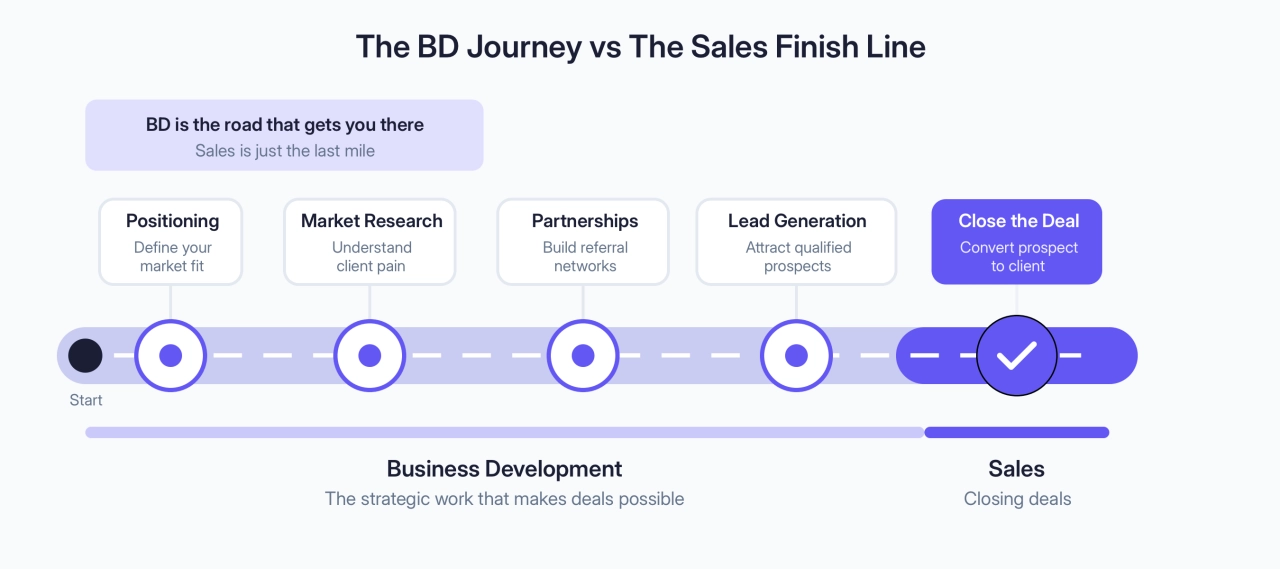
For agencies, BD breaks down into three areas:
Marketing is how you attract attention. Content that ranks. Ads that convert. A portfolio that makes prospects reach out. This is inbound, clients finding you instead of you chasing them.
Sales is how you convert that attention into revenue. Proposals, discovery calls, negotiations, closing. Most agency owners are decent at this part because they understand their own services.
Networking is how you build relationships that pay off over time. Referral partners. Industry connections. Former clients who send you business years later. This is the slowest channel but often the most valuable.
Why BD works differently for agencies
Product companies can run ads, show features, and close sales in a day. Agencies can’t.
When someone buys a product, they know what they’re getting. When someone hires an agency, they’re betting on a promise. They’re trusting you to solve a problem they can’t solve themselves, often with significant money on the line.
Peter Lewis, CMO at Strategic Pete, put it well:
You’re not convincing someone to buy a thing—they’re deciding whether or not to entrust you to solve their problem.
 Peter Lewis,
Strategic Pete
Peter Lewis,
Strategic Pete
That’s a much bigger ask than “click buy now.”
This is why agency BD takes longer, requires more touchpoints, and depends heavily on trust signals like case studies, referrals, and reputation. You can’t shortcut it. But you can get better at it.
Inbound vs. outbound BD for agencies
Every agency needs both. The question is how much of each, and when.
Inbound BD
Inbound is when clients come to you. They find your blog post, read your case study, see you speak at a conference, or get referred by someone they trust. By the time they reach out, they already believe you can help.
This is the dream scenario. Warm leads who’ve pre-sold themselves. Higher close rates. Less time spent convincing and more time scoping.
The catch? Inbound takes time to build. You need content that ranks. A reputation that precedes you. A referral network that actually refers. None of that happens in a month.
Vukasin Ilic, CEO at Digital Media Lab, describes how it works:
By consistently sharing insights, experiences, and value on platforms like LinkedIn or industry-specific forums, I’ve attracted highly engaged prospects who already trust my expertise. These leads are pre-qualified through the trust built over time.
 Vukasin Ilic,
Win the Search
Vukasin Ilic,
Win the Search
That’s inbound in a nutshell. Provide value, build trust, wait for the phone to ring.
Outbound BD
Outbound is when you go find clients. Cold emails. LinkedIn outreach. Networking events. Knocking on doors, metaphorically or literally.
Outbound gets a bad rap because most people do it badly. Spray-and-pray emails. Generic pitches. Pestering strangers who never asked to hear from you. That version of outbound deserves its reputation.
Good outbound is different. It’s targeted. It’s personalized. It leads with value instead of an ask. And it works, especially when you need pipeline now, not six months from now. We cover this in detail in our outbound lead generation guide.
The downside is that outbound requires constant effort. Stop doing it and the leads stop coming. There’s no compounding effect like with content or referrals.
Finding the right mix
New agencies should lean heavily on outbound. You don’t have the content library, the reputation, or the referral network yet. You need clients now, and outbound is the fastest path.
A reasonable split for a new agency: 70% outbound, 30% inbound. Spend most of your BD time on direct outreach while slowly building your content and referral engines in the background.
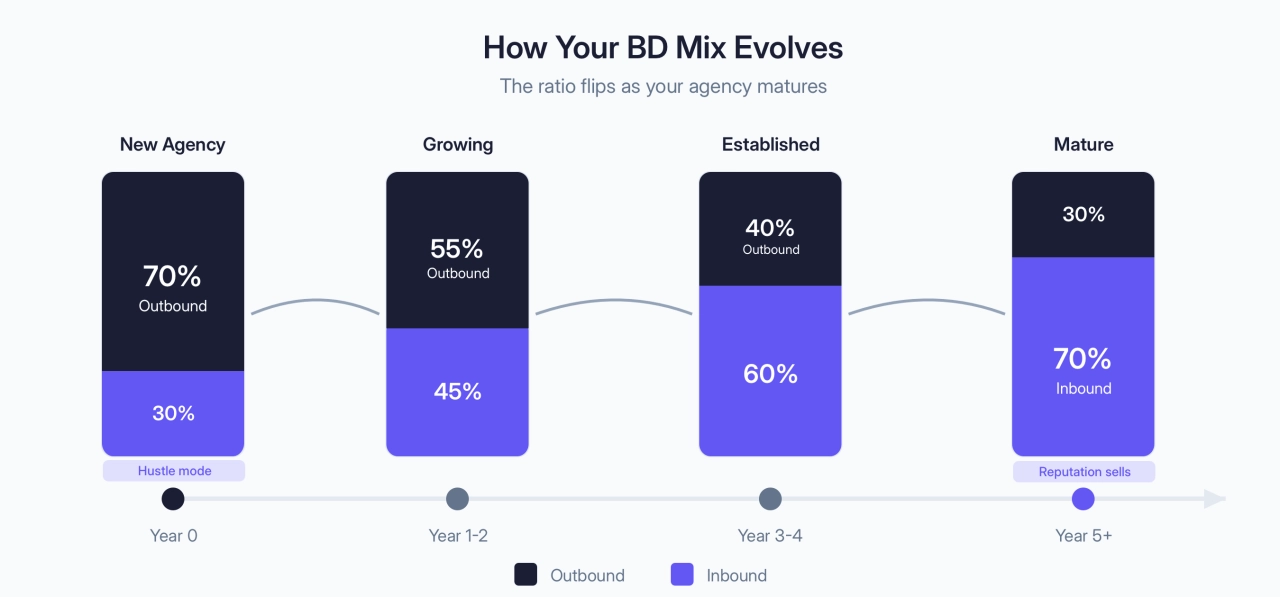
As your agency matures, flip the ratio. Established agencies with strong reputations can run 70% inbound, 30% outbound, or even more lopsided. At some point, your reputation does most of the selling for you.
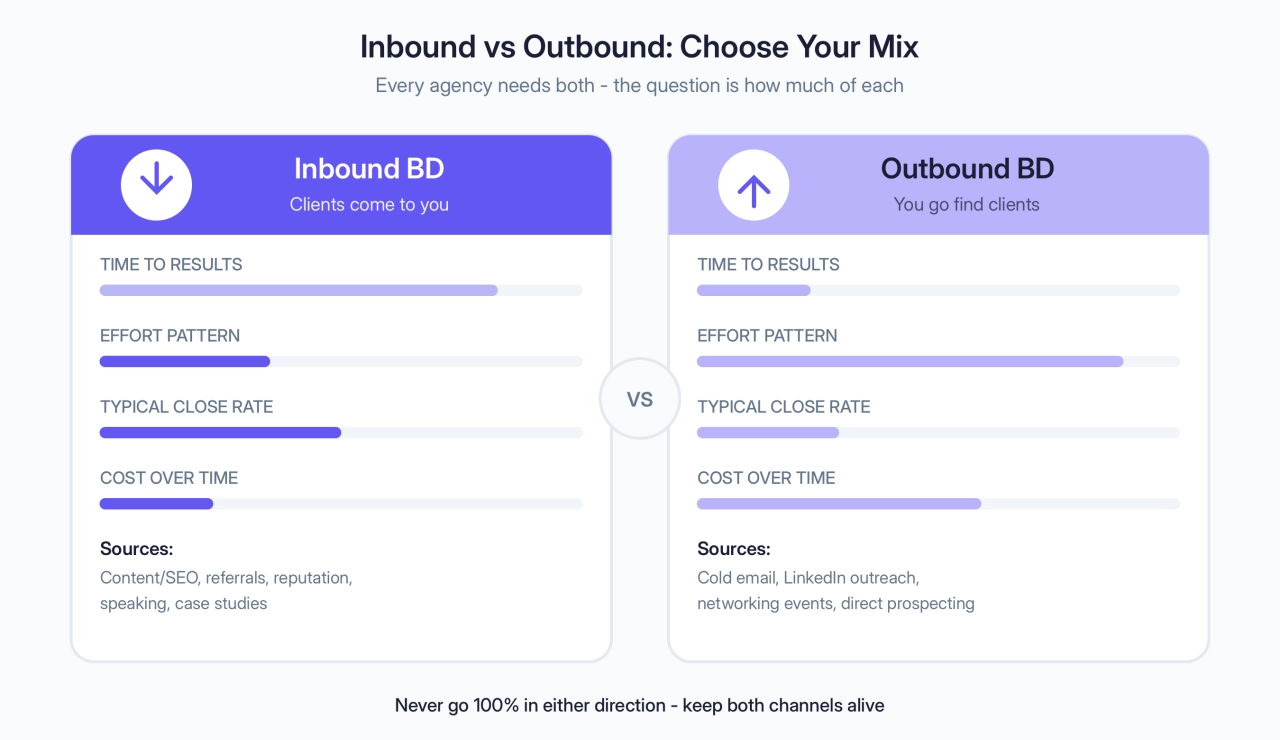
One thing to avoid: going 100% either direction. Agencies that rely entirely on inbound get complacent and panic when a Google update tanks their traffic. Agencies that rely entirely on outbound burn out their sales team and never build lasting assets. Keep both channels alive, even if one dominates.
10 BD strategies to grow your agency
I’ve watched hundreds of agencies use SPP.co over the years. The ones that grow share a few habits. Here’s what works.
1. Know your client’s pain better than they do
Your SEO client doesn’t want “comprehensive keyword research.” They want more leads. Talk to them. Read their reviews. Join their communities. Then reflect that pain in everything you write: your website, your proposals, your case studies. When prospects feel understood, they trust you faster.
2. Niche down
Generalists compete on price. Specialists compete on value.
Jonathan Solorzano ran a web dev agency that took any project. Busy, but not growing. After narrowing to Shopify and WooCommerce only, he could charge more and attract clients who specifically wanted his expertise.
3. Productize your services
Fixed scope. Fixed price. No custom proposals for every prospect.
Garrett Smith tested his Google Business Profile management idea with a simple site and SPP.co handling orders in the backend. Productizing let him validate demand fast and scale once he saw traction.
4. Build a referral engine
Referrals don’t just happen. You design for them.
Ask at the right moment: after a win, not randomly. Make it easy. Offer an incentive if it fits your brand. A formal program helps: give clients a reason to refer and track who does.
Victoria Lee at 100 Pound Social grew her client base by 215% after getting serious about referrals. We have a full breakdown on how to run an agency referral program.
5. Turn clients into bigger clients
There’s a 5–20% chance of selling to a new prospect. With existing clients? 60–70%.
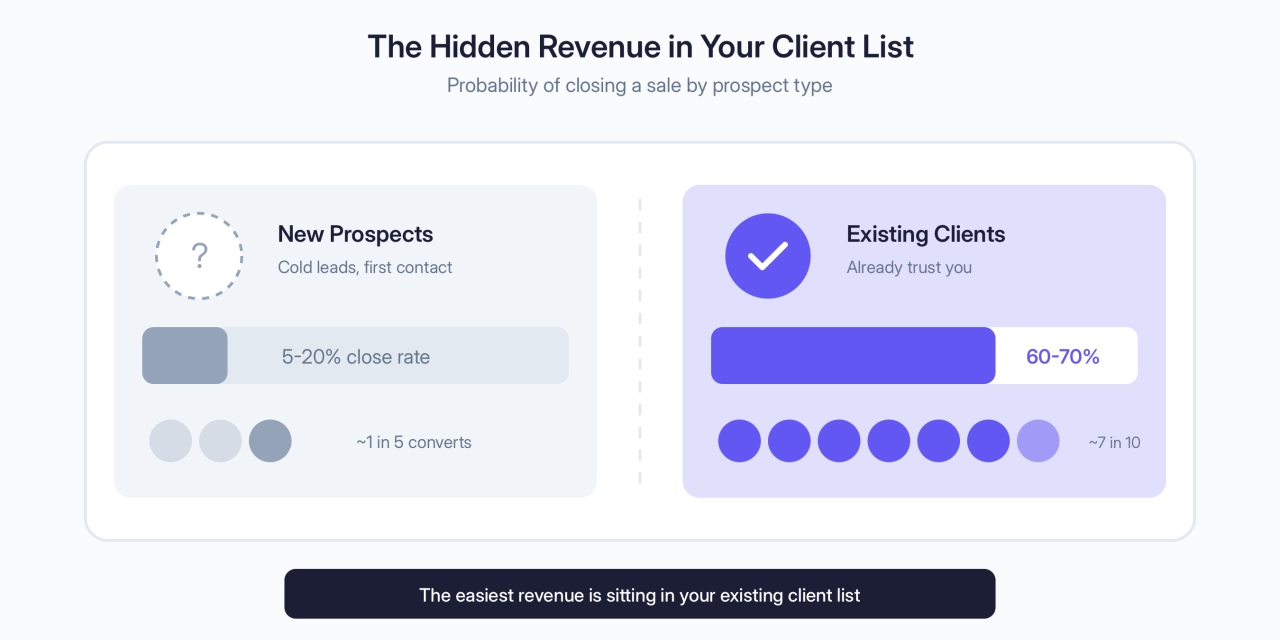
Most agencies chase new logos while their current clients take extra budget elsewhere. Cross-sell adjacent services. Upsell to bigger packages. Tie it to their goals, not your revenue.
A few ways to do this:
Quarterly business reviews: Schedule a call every 90 days to review results and discuss what’s next. This is where expansion conversations happen naturally. You’re not pitching, you’re planning together.
Spot the gaps: Your SEO client probably needs content. Your web design client probably needs ongoing maintenance. Your PPC client probably needs landing page help. If you don’t offer it, someone else will.
Propose before they ask: Don’t wait for clients to come to you with new projects. When you see an opportunity, bring it up. “Based on your traffic growth, I think you’re leaving money on the table without email capture. Want me to scope that out?”
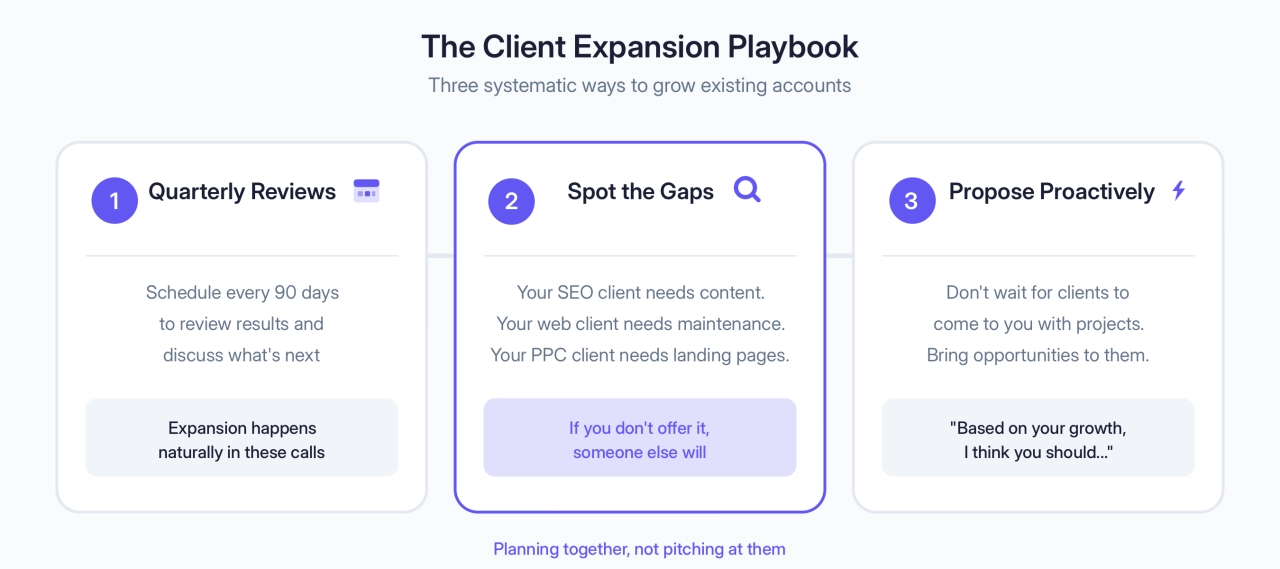
The easiest revenue is sitting in your existing client list. Most agencies ignore it.
6. Build strategic partnerships
Find agencies that serve your clients but don’t compete with you. Send each other business.
Taylor Scher, a SaaS SEO consultant, explains how he built these relationships:
I’ve worked out a few partnerships with web design agencies where I’ll refer them web design clients, and they’ll refer me SEO clients. It’s a win-win for both parties and helps both of us grow without additional marketing spend.
 Taylor Scher,
Taylor Scher Consulting
Taylor Scher,
Taylor Scher Consulting
We wrote more about structuring these relationships in our guide to agency partnerships.
7. Build a brand, not just a business
Your brand is why someone picks you over fifty other agencies offering the same thing.
Tell your origin story. Have a point of view. Show the humans behind the work. Invest in how you present yourself. Nick Meagher built an SEO agency with 10+ year client retention. That kind of loyalty comes from brand, not just results.
8. Prove it with case studies
Case studies are the closest thing to proof you can offer. Structure them around the problem, what you did, and the measurable result.
Get specific. Use numbers. Name clients when you can. A good case study works on your website, in proposals, and during sales calls. Check out our case study page for examples.
9. Systematize your operations
If every project is chaos, you can’t scale. You’ll spend all your time firefighting.
Onboarding. Project tracking. Invoicing. Renewals. The more you templatize and automate, the more capacity you have for actual BD work. Adam Steele moved Loganix, a $3M/year agency, from a custom-built dashboard to SPP because managing operations was eating his time.
10. Track the right metrics
Revenue growth rate. Client acquisition cost. Average deal size. Lifetime value. Churn.
If you don’t know these numbers, you’re guessing. We have a full breakdown in our KPI guide for agencies.
Landing your first major client
Every agency starts at zero. No portfolio, no testimonials, no referrals. Just you trying to convince someone to take a chance.
The cold start is brutal. Prospects want proof you can deliver, but you can’t get proof without clients. It’s a chicken-and-egg problem that kills a lot of agencies before they get going.
Here’s what actually works.
Get in front of the right rooms
Paige Arnof-Fenn, Founder & CEO at Mavens & Moguls, landed her first major client from a talk she gave to a professional networking group:
Someone from the audience came up to me after and made an introduction which resulted in my first project a few weeks later. It was a 1 year agreement for a six figure engagement.
 Paige Arnof-Fenn,
Mavens & Moguls
Paige Arnof-Fenn,
Mavens & Moguls
That was 24 years ago. She still gives talks to generate leads.
Speaking, webinars, podcasts, industry events. These put you in front of people who are already interested in your topic. You’re not cold pitching. You’re demonstrating expertise to a warm audience.
Find where your potential clients gather and show up with something useful to say.
Start small and stack proof
Victor Hsi built his link building agency by taking small jobs first. Cheap listings on local marketplaces. Tiny projects. He kept stacking proof until one of those small jobs turned into a $10k deal.
His advice: “Start with low-ticket listings, reply fast, over-deliver a bit. Big accounts usually come from small ones that trust you first.”
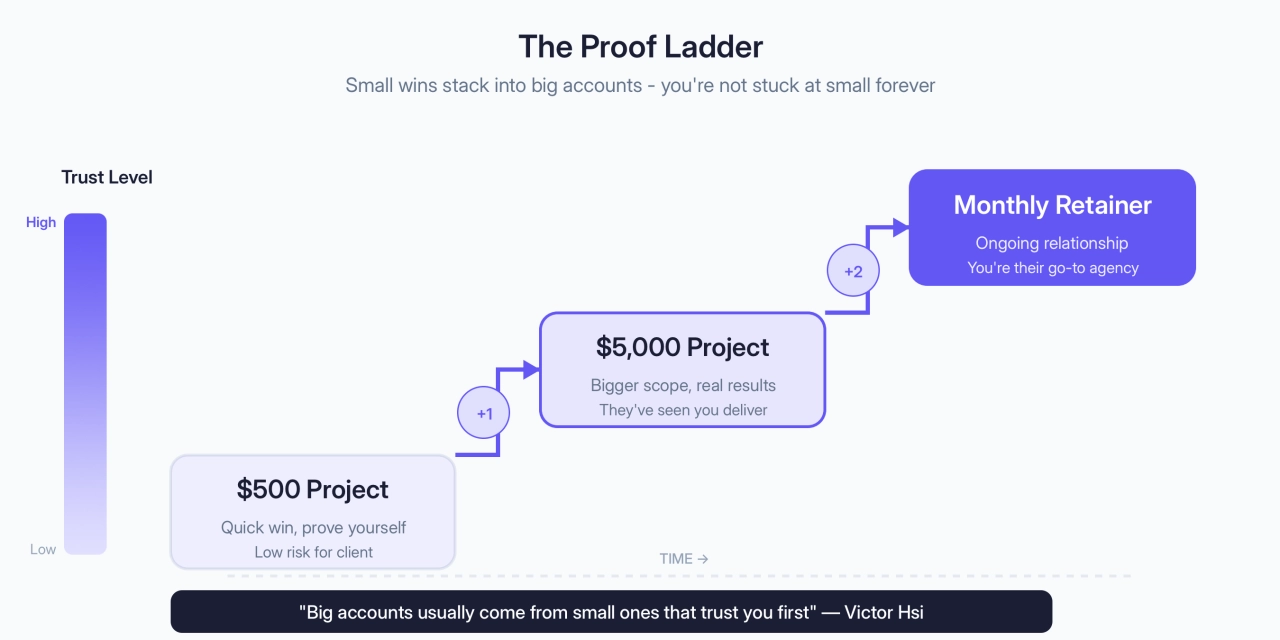
This works for agencies too. A $500 project done well leads to a $5,000 project. A $5,000 project leads to a retainer. You’re not stuck at small forever. You’re building a ladder.
Partner with someone who already has the audience
Adriana Stein, CEO at AS Marketing, uses partnerships as a client acquisition channel:
At my marketing agency, AS Marketing, we regularly work with partners to collaborate on events like webinars. We have found this to be a highly effective way to grow brand awareness and generate leads. And ironically, that experience with our partners has given them the trust for many of them to become our clients and refer other clients as well.
 Adriana Stein,
AS Marketing
Adriana Stein,
AS Marketing
Find businesses that serve your audience but don’t compete with you. Collaborate on something useful. The partnership itself becomes the trust-building mechanism that turns into client relationships.
Use your past life
Before you started your agency, you worked somewhere. You know people. Those relationships are your warmest leads.
Former colleagues who moved to companies that need your services. Old bosses who trust your work. Friends of friends who mention they’re looking for help. These aren’t cold pitches. They’re conversations with people who already know you deliver.
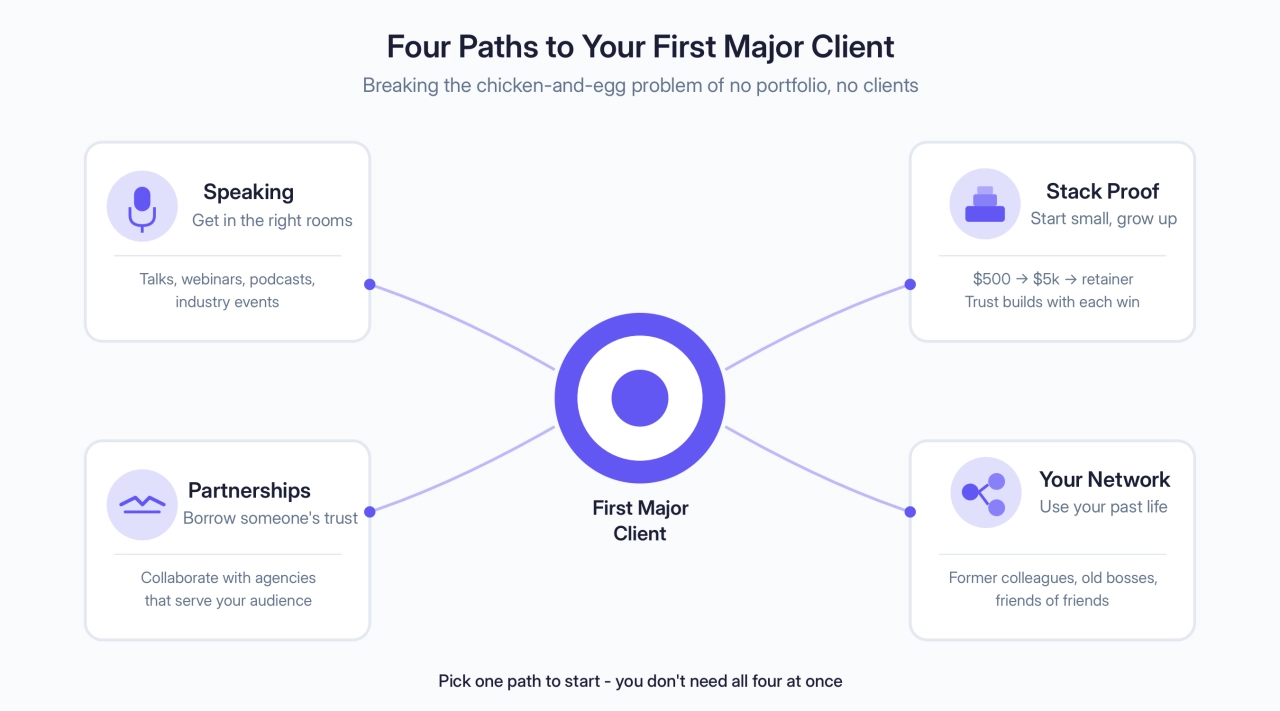
Thibault Garcia at Reachly spent six months getting crickets on Fiverr before he figured out that his network was the faster path. Now he runs a six-figure lead gen agency with 50+ clients across 6 countries.
Offer a pilot
If a prospect is hesitant, reduce the risk. Offer a smaller engagement with a clear deliverable. One month instead of six. One campaign instead of a full retainer.
You’re not discounting your work. You’re letting them test the relationship before committing. If you deliver, the full engagement follows.
Common BD mistakes agencies make
I’ve seen these kill pipeline over and over.
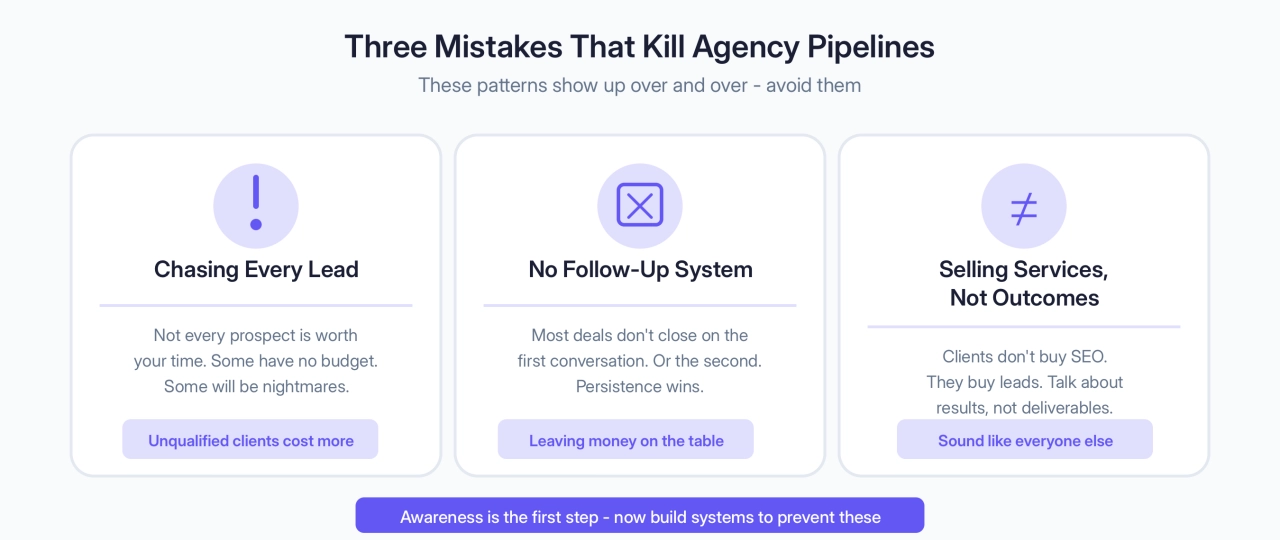
Chasing every lead
Not every prospect is worth your time. Some have no budget. Some will be nightmares to work with. Some want things you can’t deliver.
Unqualified clients cost more than no clients. They drain your time, wreck your margins, and leave bad reviews. Learn to say no early.
No follow-up system
Most deals don’t close on the first conversation. Or the second. Research varies, but the pattern is consistent: persistence wins.
If you’re not following up, you’re leaving money on the table. Build a system. Set reminders. Keep track of who you’ve talked to and when. The agencies that follow up are the ones that close.
Selling services instead of outcomes
Clients don’t buy SEO. They buy leads. They don’t buy PPC management. They buy lower acquisition costs.
When you pitch services, you sound like everyone else. When you pitch outcomes, you sound like the solution to their problem.
Budgeting for agency business development
How much should you spend on BD? There’s no magic number, but there are reasonable ranges.
The baseline
Most established agencies spend 5–15% of revenue on business development. That includes marketing, sales tools, events, content, ads, and any team members focused on growth.
Early-stage agencies should spend more, not less. When you have no pipeline, no reputation, and no referral network, you need to invest heavier to build those assets. 15–20% of revenue isn’t unreasonable when you’re starting out.
As your agency matures, the percentage can drop. Referrals kick in. Content starts ranking. Reputation generates inbound. You’re not starting from zero every month.
Where the money goes
Here’s where most agencies allocate their BD budget.
Content and SEO is a long game. Blog posts, case studies, landing pages. It takes months to pay off but compounds over time. Budget for writers, designers, or your own time if you’re doing it yourself.
Paid acquisition works faster but stops the moment you stop spending. Good for testing messages, filling gaps in pipeline, or entering new markets. Budget for ad spend plus someone who knows what they’re doing.
Events and networking is relationship capital. Conferences, dinners, industry meetups. Hard to measure directly but often where the biggest deals start. Budget for tickets, travel, and the time you spend there.
Tools and software adds up. CRM, email marketing, proposal software, analytics. Audit what you’re paying for and cut what you’re not using.
When to hire BD help
You can’t do everything yourself forever. At some point, you need people focused on growth so you can focus on delivery.
Your options
There are a few ways to get BD help without building a full team.
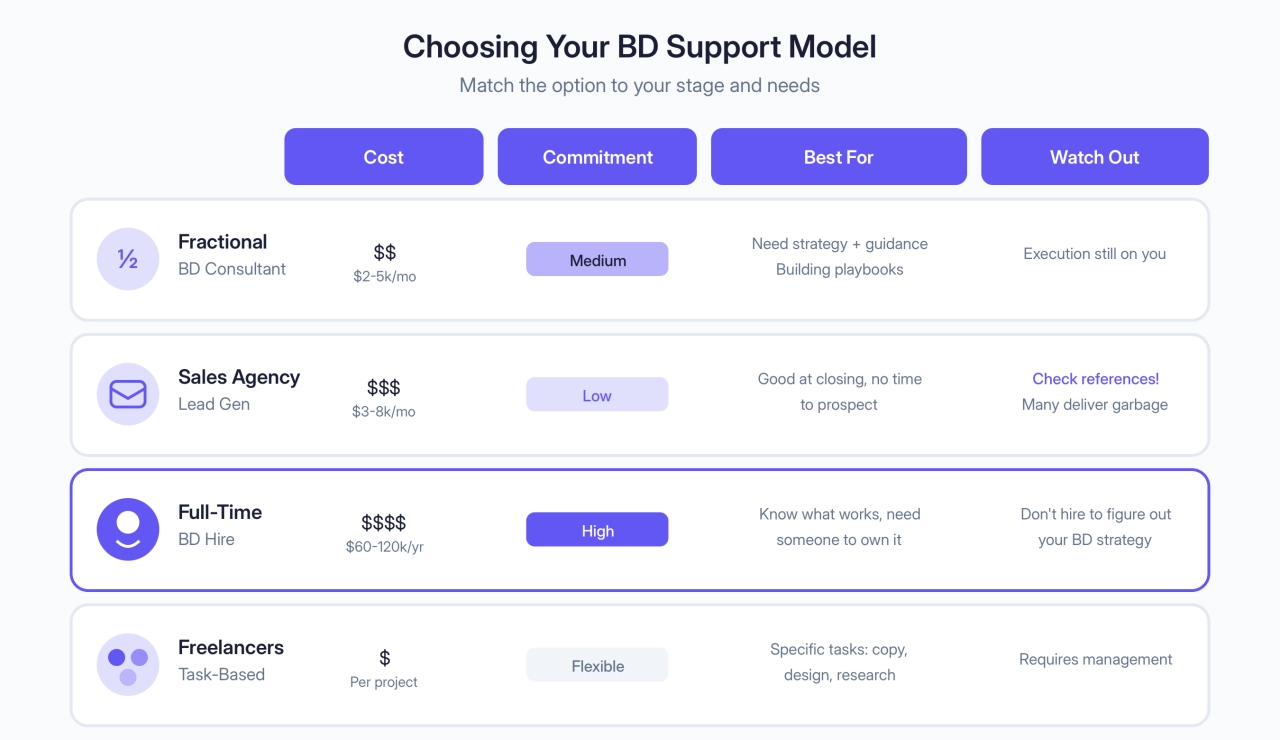
Fractional BD consultant: Someone experienced who works with you part-time. Good when you need strategy and guidance but not a full-time salary. They can build your playbook, train your team, or run specific initiatives.
Sales agency for lead gen: They find prospects and book meetings. You close. Works when you’re good at selling but don’t have time to prospect. Be careful here. Lots of agencies promise leads and deliver garbage. Check references.
Full-time BD hire: Someone who owns your pipeline. Prospecting, outreach, follow-up, maybe closing. This is a real commitment. Salary, benefits, management time. Only makes sense when you have enough volume to keep them busy.
Freelancers for specific tasks: A copywriter for outreach emails. A designer for your pitch deck. A researcher to build prospect lists. Cheaper than hiring, more flexible, but requires more management from you.
Signs you’re ready
Not sure if it’s time? These patterns usually mean yes.
You’re turning down work: Not because you’re at capacity, but because you don’t have time to sell. A dedicated BD person fixes this.
Pipeline is inconsistent: Good months, bad months, no idea why. You’re too busy with client work to do outreach, so leads dry up. Then you scramble, fill the pipeline, get busy again, and the cycle repeats.
Your time is worth more elsewhere: If you bill $300/hour for strategy work, spending ten hours a week on cold outreach is expensive. Hire someone at $30/hour to do prospecting and spend your time on what only you can do.
You’ve figured out what works: Don’t hire someone to figure out your BD strategy from scratch. Hire once you know which channels work, what messaging resonates, and what your sales process looks like. Then you’re handing off a playbook, not a puzzle.
Frequently asked questions
How long does it take for inbound BD to start generating leads?
Expect 6–12 months before content and SEO produce consistent inbound leads. Referral networks can work faster if you actively build them, sometimes within 3–6 months. The agencies that give up on inbound after 90 days never see the compounding returns.
What’s a good close rate for agency sales calls?
20–30% is solid for cold outreach. 40–50% is realistic for warm leads and referrals. If you’re below 20%, the problem is usually qualification, not sales skills. You’re talking to the wrong people.
Should agency founders do BD themselves or hire for it?
Founders should do BD themselves until they’ve closed at least 20–30 clients. You need to understand what works before you can hand it off. Hiring too early means paying someone to figure out your sales process through expensive trial and error.
How do I do BD when I have no case studies yet?
Lead with process, not proof. Explain how you’ll solve their problem step by step. Offer a pilot at reduced risk. Use results from past employment if relevant. One good project with documented results is enough to start the flywheel.
Does pricing affect business development?
Directly. Price too low and you attract budget clients who churn fast and drain resources. Price too high without the brand to back it and you’ll struggle to close. Most new agencies underprice. If you’re closing more than 50% of proposals, your prices are probably too low.
Where to start
If you’re not sure what to do first, here’s the order I’d prioritize:
Talk to five current clients this week: Ask what else they need. Expansion revenue is the fastest win.
Set up a follow-up system: Even a spreadsheet works. Track every prospect, every conversation, every next step.
Ask for one referral: Pick your happiest client. Ask who else they know that might need help.
Block two hours a week for outbound: Consistent prospecting beats sporadic bursts.
Write one case study: Your best project, with real numbers. Use it everywhere.
That’s enough to move the needle. Everything else can wait until these are working.

